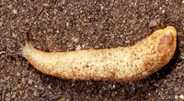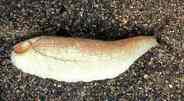
Testacella scutulum Description: Large slug, extended length 8 - 12 cm. Yellow, speckled with black or brown, foot fringe and sole usually orange. Lateral grooves (which do not show up well in this illustration) join before reaching a common origin at the front edge of the mantle, just under the shell.

Testacella haliotidea Description: Large slug, extended length 8 - 12 cm. Usually dull creamy-white or yellow above, usually with a whitish foot-sole. Points of origin of lateral grooves at the front edge of the mantle (which are more obvious in this illustration) close together, but distinct.

Testacella maugei
Description: Medium to large slug, extended length 6 - 10 cm. Brown, speckled with black above, with a double row of conspicuous tubercles, and paler sides.Foot fringe and sole brighter, often pink or orange. Points of origin of lateral grooves about 5 mm. apart at the mantle. Shell larger than the other species, oblong and convex. 12 - 16 mm. long, 6 - 7 mm. wide. There are a number of colour varieties - grey, greenish-brown, rufous and black.
